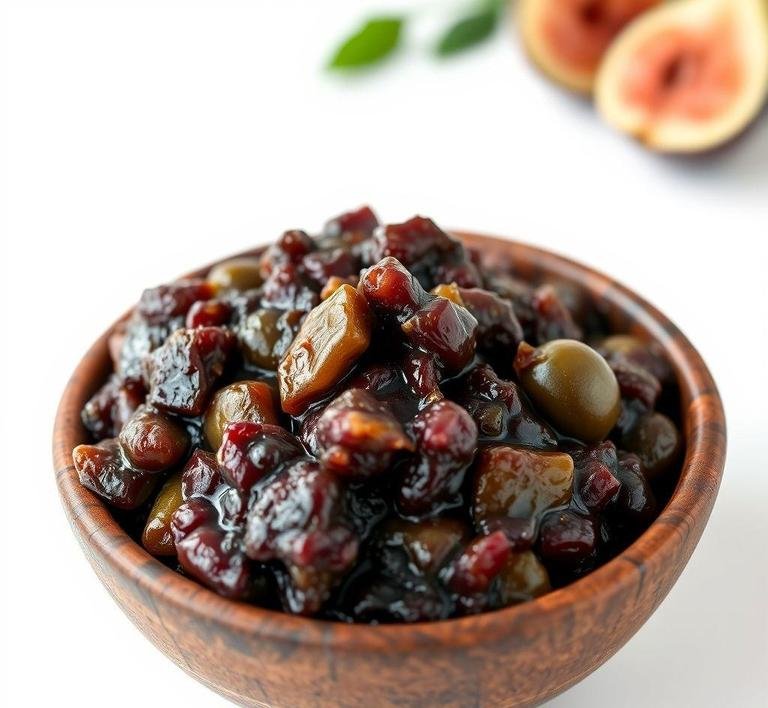Let me paint you a picture. It was a rainy autumn afternoon, the kind where the light fades too quickly and everything smells like damp leaves and firewood. I was curled up in the corner of my kitchen with one of Nigella Lawson’s cookbooks. the one with pages splashed with oil and sauce from years of use, the spine barely holding together. That’s when I stumbled across her Fig and Olive Chutney recipe. The name alone made me pause. Fig. Olive. Chutney. Sweet and salty. Plush and punchy. A contrast that just sounded… interesting. But what I didn’t expect was how completely it would hijack my senses.
Nigella’s Fig and Olive Chutney isn’t your average preserve. It’s a sultry mix of dried figs-plump and rich with natural sugar. and briny, almost smoky black olives. The sweetness is not cloying, the saltiness not too assertive. Instead, they tango together, pulled tight by the dark warmth of vinegar and gentle spices. It’s the kind of condiment that turns a slice of aged cheddar or a boring leftover sandwich into something almost illicitly good.
And it’s not just about taste. it’s about mood. Nigella always had a way of making food feel decadent, even when it was practical. Her chutney is just that. It keeps well, makes for a gorgeous gift and adds a level of sophistication to even the most humble cracker. It became my secret weapon at dinner parties. Slathered on grilled bread with goat cheese. Swirled into roasted vegetables. Or honestly, just eaten by the spoonful when no one was watching.
Nigella Fig And Olive Chutney Recipe
Ingredients Needed

Now, let’s talk about what goes into this little jar of seduction. These are pantry staples elevated, nothing too obscure and yet each one has a role in creating that layered, deeply satisfying result.
Here’s what you’ll need:
- 200g dried figs, roughly chopped. These are the soul of the chutney, sweet, chewy and almost caramel. like when cooked down.
- 200g black olives, pitted and chopped. The key here is to get olives with real character, not the canned bland kind. Kalamata works beautifully.
- 1 medium red onion, finely chopped. It brings a mellow bite that balances out the sweetness.
- 125ml red wine vinegar. This adds tang and depth, like a velvet ribbon tying all the bold flavors together.
- 125ml water – Just enough to keep everything bubbling gently.
- 150g soft brown sugar. It melts into the mix, bringing that sticky, rich sweetness chutney is known for.
- A pinch of chili flakes (optional). Nigella doesn’t always add this but I do. Just enough for a whisper of heat.
- A sprig of rosemary or a pinch of dried thyme. This is my addition. Not essential but a herbal note lifts the whole thing.
I remember the first time I made it, I had to stop myself from doubling the sugar (as a sweet tooth always tempted me to do) but Nigella’s ratios are near-perfect. Trust the process.
Equipment Needed
You don’t need a kitchen full of gadgets to pull this off. It’s refreshingly simple which is part of its magic.
Here’s what I use:
- A sharp knife and cutting board. Chopping figs and olives requires a bit of patience and a good blade.
- A heavy-bottomed saucepan – This is crucial. Chutney needs to simmer gently without catching or burning.
- A wooden spoon – The kind that feels like it knows how to stir things into magic.
- A clean jar or two. If you’re making this ahead or gifting it (and trust me, it makes a killer host gift), sterilize your jars first. I usually run them through a hot dishwasher cycle and dry them in a warm oven.
That’s it. No blenders, no processors, just honest, hands-on cooking.
Instructions To Make Nigella Lawson’s Fig And Olive Chutney
This is the kind of cooking that feels like therapy-slow, fragrant and oddly satisfying.
- Prep everything first. Roughly chop the figs and olives, finely dice the onion, measure out your sugar and vinegar. You don’t want to be scrambling mid-simmer. I made that mistake once-missed adding the vinegar until too late. Not pretty.
- In a heavy pan, warm a splash of olive oil and gently sauté the onion. Don’t rush it. Let it get translucent and soft, almost melting.
- Add the figs and olives, then pour in the red wine vinegar and water. Stir gently and inhale. The scent is oddly intoxicating.
- Tumble in the brown sugar and stir until it dissolves. At this point, it looks like a mess. But give it 30-40 minutes on a very gentle simmer and magic happens.
- Simmer low and slow, stirring now and then. The mixture should thicken into a glossy, sticky chutney. It’ll reduce, deepen in color and fill your kitchen with a scent that’s somewhere between a vineyard in the fall and a tapas bar at midnight.
- Taste as you go. Maybe add a touch of chili or a few leaves of rosemary halfway through. Adjust as your instincts guide you.
- Once it’s thick and jammy, spoon it into sterilized jars, seal while hot and let it cool. If you can wait a day or two before using, the flavors settle in beautifully. I usually make a double batch and stash one in the fridge for emergency cheese boards.
What I Learnt
Making chutney taught me patience. You can’t rush flavor. You have to coax it out with time and gentle heat. And maybe that’s why I love this recipe so much. it’s a reminder that good things are worth waiting for.
It also reminded me that savory and sweet aren’t opposites-they’re soulmates. There’s a sort of emotional layering that happens when you pair figs with olives, onions with sugar. The first time I spooned it onto a grilled sandwich with Manchego cheese and arugula, I actually laughed. It was that good.
I learned to trust my taste buds, too. Nigella gave me the map but I started adding my own landmarks-extra herbs, a dash more vinegar, even a splash of port once. It became my chutney, built on her brilliant bones.
FAQs
Can I Use Fresh Figs Instead Of Dried Figs In Nigella’s Chutney?
Absolutely! Fresh figs work just as well, though they do add a bit more moisture. I’ve tried it both ways, and fresh figs bring a delightful, juicier texture to the chutney, but if you’re looking for a more concentrated sweetness, dried figs will give you that extra depth of flavor.
What’s The Best Way To Store Nigella’s Fig And Olive Chutney?
After making it, let the chutney cool completely before transferring it to jars. Store it in a cool, dark place if you want it to last for several months. The flavors really deepen over time! If you’ve got leftovers after opening a jar, just pop it in the fridge-should stay good for about 2 weeks. Trust me, though, it never lasts that long at my place.
Can I Substitute The Olives In Nigella’s Chutney If I’m Not A Fan Of Them?
Sure! You can swap out the olives for something like capers or even a few more figs to keep the sweetness balanced. However, I’d say the olives add a unique tanginess that makes the chutney stand out, so if you can tolerate them, they’re definitely worth keeping in. But hey, I totally get it-if olives aren’t your thing, the chutney will still be great without them!


